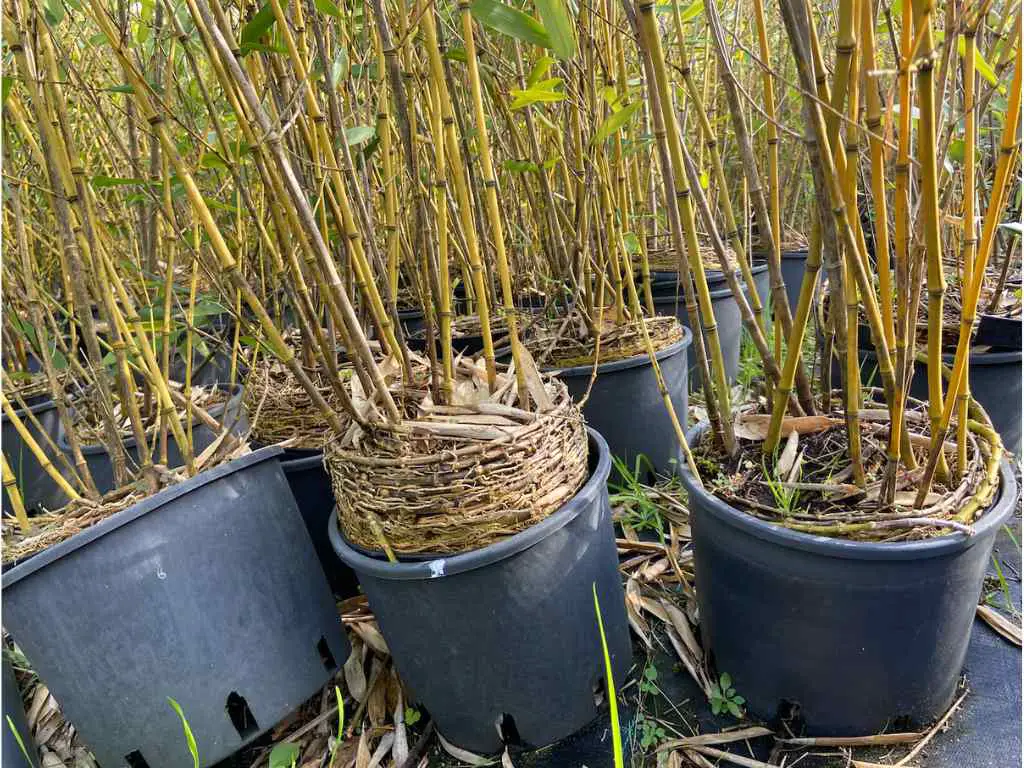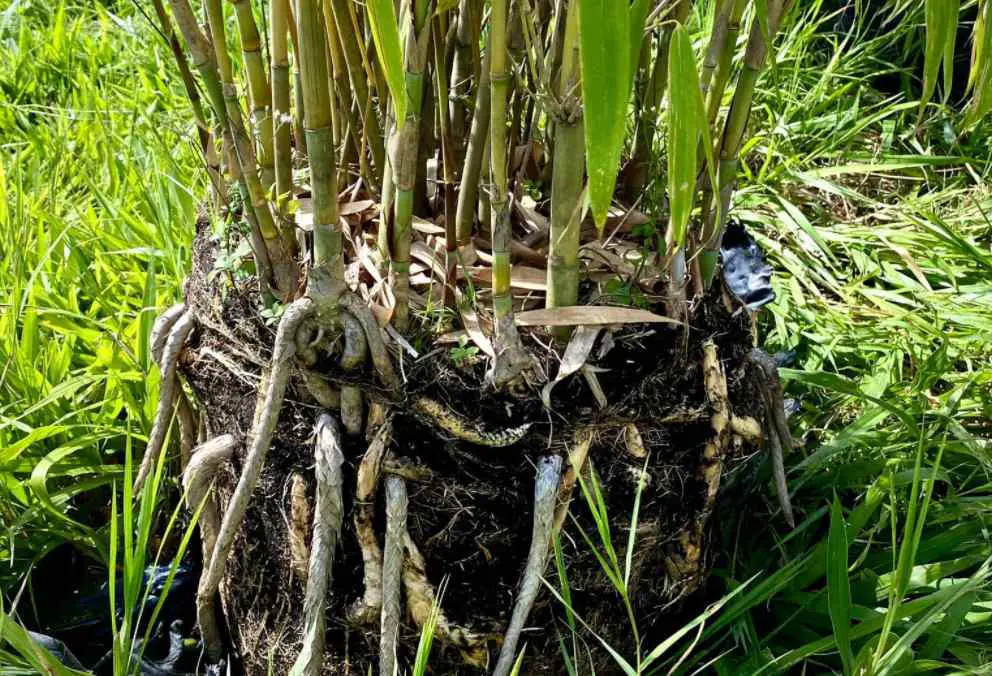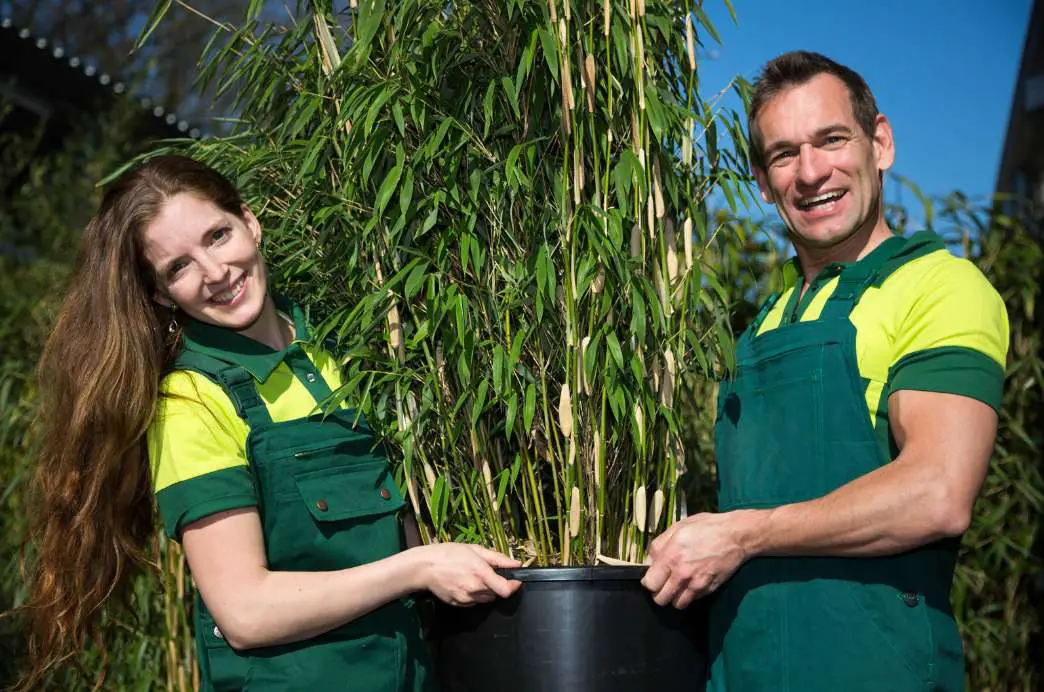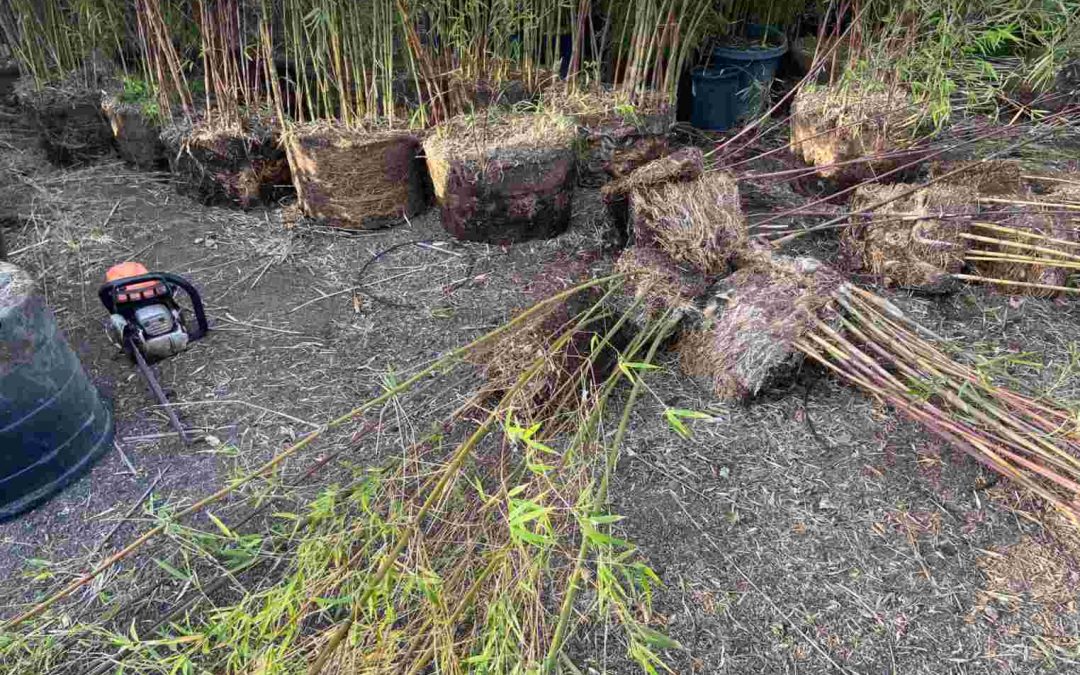We admire bamboo for its strength, its resilience, and its tenacious will to live. Not only is it the most useful and versatile plant on earth, it’s also the fastest-growing. Bamboo is beautiful to look at as well, with its tall, elegant culms and its tufts of graceful foliage. In the ground or in the wild, it can spread with vigorous ferocity. Therefore, many gardeners prefer to domesticate the beast, keeping their bamboo in a pot or a container. Even so, a potted bamboo plant will still require maintenance and attention.
If you’re growing bamboo in a pot or container, you need to repot or transplant it periodically to prevent it from getting root-bound. When bamboo gets root bound, the whole plant suffers. Leaves will turn yellow and fall off, it will fail to produce healthy new shoots, and the weak plant can become susceptible to pests. Before it gets root bound, it’s important to remove the bamboo from the pot and trim the roots. At this point, you can transplant it into a larger container or divide the root mass into separate, individual specimens.
NOTE: This article first appeared in December 2020, last updated in April 2023.
Transplanting and upsizing vs. Dividing and multiplying
If you have a potted bamboo plant with an overcrowded root ball, you basically have two solutions to choose from. But they both involve repotting your bamboo. The first option is to simply move the bamboo plant from a small pot into a larger one. If the bamboo is not already root-bound, this will be a pretty easy procedure. You can do it any time of year. But if the roots are already getting bound up, the process will be slightly more involved.
The second option is more interesting, but also a bit more complicated. Whether or not the bamboo is already root-bound, you can divide a single root ball into multiple plants or cuttings. This will require more work, and you want to be careful to do this in the dormant season. But it can result in you having three or four plants instead of just one. Most varieties of bamboo can handle such a division pretty well. But you might not have 100 percent success, especially if you are going to make several smaller sections. Better to lose one or two divisions, however, than to lose the whole plant because it got strangled by its own roots.
NOTE: The thick roots of a bamboo plant, which resemble the stems (culms), are technically rhizomes. With running bamboo, they extend outward, parallel to the ground, and with clumping bamboo, they tend to bend upward. The roots, on the other hand, are the little, soft, white tendrils that grow off of the rhizomes to draw water and nutrients from the soil. In some cases, this is an important botanical distinction. But in this article, we may use the terms interchangeably. A “root bound” bamboo actually suffers from bound-up rhizomes, but nobody ever says “rhizome bound”. So we typically refer to the mass of rhizomes as a “root ball”.

Why you should repot your bamboo
In nature, bamboo roots and rhizomes have plenty of room to spread, outward and downward. But in a container, they can run out of space quickly. As the roots get overcrowded, the plant can suffer in a number of ways. But most importantly, the bamboo will have difficulty getting the water and nutrients from a container filled more with roots and less with soil.
In some cases, it’s not uncommon for the bamboo to get so root bound, with its thick and chunky rhizomes, that the water can’t even penetrate the soil. Instead, most of the water ends up just running off the top. You might feel like you’re overwatering the bamboo, when in fact the roots trapped under the soil are completely parched.
Symptoms of overwatering are actually similar to what happens with a root-bound bamboo. The leaves may curl and lose their bright green color. As they turn yellow, they also begin to drop. Meanwhile, the thirsty and unhealthy plant is failing to produce fresh new leaves or culms. Or if they do, there aren’t as many leaves, and the new shoots aren’t as big as they should be.
Try sticking your finger into the soil. If it’s soggy, then you’re overwatering. If you can’t get your finger into it, then it’s root-bound.

When to repot bamboo
If you have a healthy bamboo plant in a small pot, say one or two gallons, the roots will probably fill in within the first year or two. Once the bamboo and its rhizomes have filled the pot, then it’s ready to move into a bigger container. As long as you are not disrupting the bamboo too much, then you can do this any time of year.
Look at the drain hole under the pot to see if the roots have reached the bottom yet. If you don’t see any roots, then it probably needs more time. Check again in a month or so.
If you do see roots, then the pot is beginning to fill out. Ideally, you’ll want to transplant it when the roots are just beginning to fill up the pot. That means the roots and soil will probably hold together when you lift it out of the pot. But you don’t want to see a ball of knots, from bamboo that’s already root-bound.
If it’s really root-bound, you might see the pot begin to bulge. This is fairly easy to see in a small, plastic pot. The rhizomes will push against the inside of the container, and then they will bend back in on themselves. This can make it difficult to remove the plant from the pot. And if you have a ceramic pot, it could be even more difficult. The pot may not survive the move.
With a seriously root-bound bamboo, you’ll need to perform something of an operation. A procedure like this will seriously disturb the roots, so you want to do it in the late fall or winter, when the plant is more dormant. This way, you are unlikely to damage fresh growth and potentially stunt the plant for the remainder of the growing season.
How to repot your bamboo
Start by getting the soil wet. Water the bamboo the night before you want to repot it. Plants are always happier after they’ve had some water. Just make sure you give it time to drain, like overnight. You want soil that’s moist, not soggy.
The first thing, as we explained above, is to know if you’re just repotting a healthy bamboo into a larger container, or if you’re dividing an impacted rootball into numerous units.
Even if it’s just a transplant, the roots and soil should probably hold together in one mostly solid mass. You might lose a little dirt when you lift it from the pot, but it’s nothing serious. You’ll be adding fresh soil and compost into the new container anyway.
If you are just transplanting, simply place the whole thing into a new pot, about twice the size of the original. Before it goes in the new pot, use a stick, a screwdriver or something similar to loosen the roots a bit. This will prepare them to stretch out and grow into the spacious new pot once transplanted. Fill in the rest of the pot with a mix of good potting soil and organic compost. Bamboo likes a lot of nitrogen, and I like to use horse manure or mushroom compost.

Dividing and repotting
Alternatively, if you’re dealing with some bamboo that’s completely root bound, you’ll need to cut back the rhizomes that are bending back on themselves, and this gives the root ball a little room to breathe. I like to use a saw to remove the bottom portion of the root mass. Assuming it was in a round pot, you’ll end up with a round disk about an inch or two thick, which you can discard.
Now you can tug and jostle the root mass a bit, and see if any sections are willing to come apart. Maybe they will, and maybe they won’t. But at some point, you’ll probably have to do some more cutting. Try to divide the main root ball into three or four even sections. At this point, it can get messy, and there may be bits and pieces that won’t survive.
Try to keep roots and culms intact as much as possible. But if you have older or less healthy culms, or any that are dry and cracked, this is the perfect time to remove them. Use these old poles to stake up your beans or tomatoes or something.
Take the surviving sections and place them in appropriate-sized pots. Ideally, you want to use something that will allow them to double or triple in size. Fill in the rest of the pot with soil and compost, as described above.
These divided cuttings are going to be more sensitive than an ordinary transplant. Keep a close eye on them, and if you live in a cold climate, you’ll want to provide some extra shelter and protection over the winter. Be sure they get enough water, and some partial shade will also be helpful. If you end up with some smaller sections, you might want to stake them up to keep them straight. If all went well, you should see some fresh, new shoots coming up in the spring.
Further reading
If you enjoyed this article about how to repot bamboo, and you’d like to learn more about growing and using bamboo, take a look at some of our most popular articles.
- Growing Bamboo: The complete how-to guide
- 9 Best bamboo species for pots or containers
- 3 Ways of propagating bamboo
- Best bamboo varieties for your garden
- Shopping for bamboo plants
- Bamboo anatomy: 9 parts of the bamboo plant
FEATURED IMAGE: Super root-bound bamboo plants require a chainsaw to be divided. (Photo by Fred Hornaday)


























Food this information very helpful as I am starting a bamboo fence this spring. Thanks!